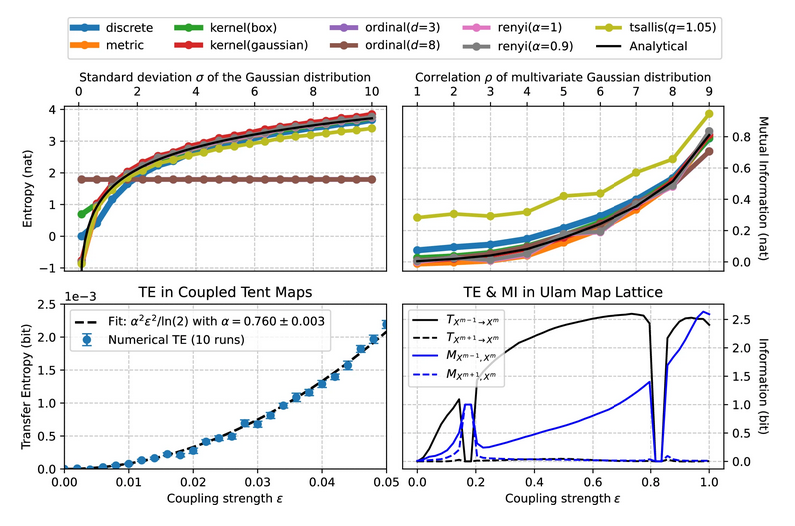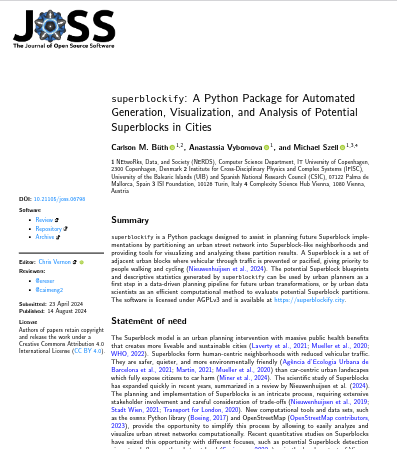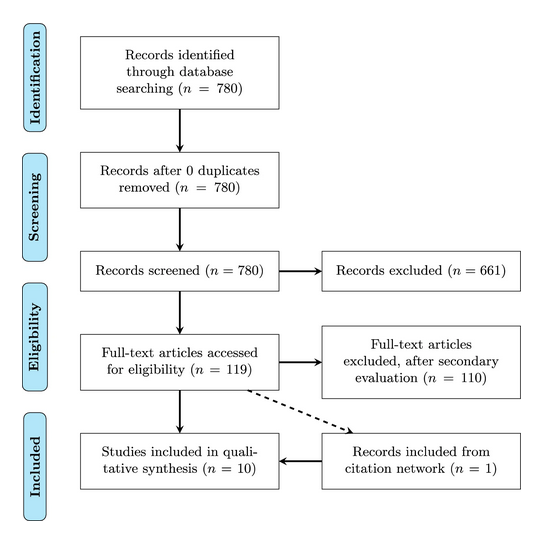Publications
publications by categories in reversed chronological order.
2025
- Preprint
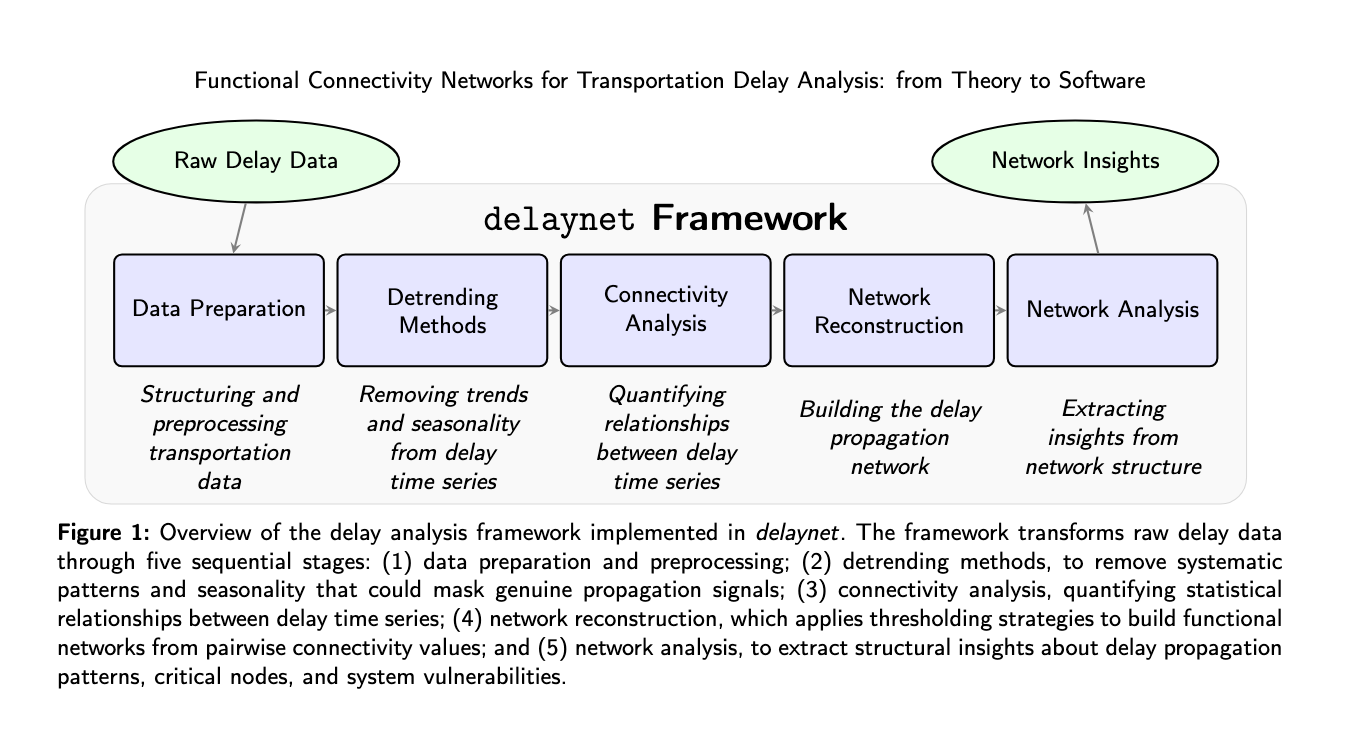 Functional Connectivity Networks for Transportation Delay Analysis: From Theory to SoftwareCarlson Moses Büth, and Massimiliano ZaninOct 2025
Functional Connectivity Networks for Transportation Delay Analysis: From Theory to SoftwareCarlson Moses Büth, and Massimiliano ZaninOct 2025Within the endeavour of modelling and understanding the propagation of delays in transportation networks, an approach that has attracted increasing interest in the last decade is the creation of functional network representations. These graphs map elements of interest (e.g. airports or stations) as nodes, and derive pairwise propagation patterns from their dynamics through correlation and causality tests. In spite of multiple notable results, this approach still lacks a coherent framework, with decisions related to many fundamental steps being left to the judgement of the researcher. We here provide an introduction to the theory behind functional networks for transportation systems, detailing the main steps and the associated pitfalls. We further introduce a Python package, delaynet, designed to support the researcher in the reconstruction and analysis of such networks. We finally present an analysis of the propagation of delays in the Swiss train system; and discuss future research steps.
@misc{buth2025-delaynet-preprint, title = {Functional {{Connectivity Networks}} for {{Transportation Delay Analysis}}: From {{Theory}} to {{Software}}}, shorttitle = {Functional {{Connectivity Networks}} for {{Transportation Delay Analysis}}}, author = {B{\"u}th, Carlson Moses and Zanin, Massimiliano}, year = {2025}, month = oct, number = {arXiv:2510.05143}, eprint = {2510.05143}, primaryclass = {physics}, publisher = {arXiv}, doi = {10.48550/arXiv.2510.05143}, archiveprefix = {arXiv}, } - Preprint
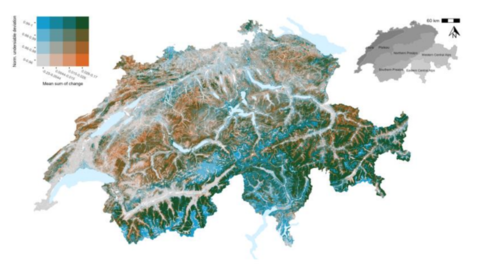 Identifying Robust Area-Based Conservation Strategies to Secure Ecosystem Service Provision under UncertaintiesBenjamin Samuel Black, Antoine Adde, Nathan Külling, and 6 more authorsSep 2025
Identifying Robust Area-Based Conservation Strategies to Secure Ecosystem Service Provision under UncertaintiesBenjamin Samuel Black, Antoine Adde, Nathan Külling, and 6 more authorsSep 2025In the 21st century area-based conservation remains the principal strategy for preserving natural habitats. However, planners must contend with uncertainties in both preferences for conservation objectives and the development of drivers of environmental degradation. To this end, this research demonstrates an approach whereby exploratory conservation strategies (e.g. timing and extent of interventions), are simulated under multiple scenarios specifying trends in major drivers, such as climate and land-use change, alongside alternative conservation priorities. With the robustness of strategies evaluated through their impetus in producing optimal trends in the provision of 10 Ecosystem Services (ES). This approach is applied to the country of Switzerland simulating the impact of conservation strategies between 2020-2060. The results show that the provision of ES will vary in both magnitude and spatial location under alternative future conditions, with regions that displayed the highest robustness not adequately covered by existing conservation prioritizations. Whereas the most robust strategies to secure ES provision were a mix of management to both restore and preserve natural land covers and the expansion of conservation areas to cover 30% of the country. However, the impact of strategies varied across ES and scenarios indicating that the final appraisal of strategies should take into account societal preferences for, and the criticality of, particular ES.
@misc{black2025-IdentifyingRobustAreabased-preprint, title = {Identifying Robust Area-Based Conservation Strategies to Secure Ecosystem Service Provision under Uncertainties}, author = {Black, Benjamin Samuel and Adde, Antoine and K{\"u}lling, Nathan and B{\"u}th, Carlson and Kurmann, Manuel and Lehmann, Anthony and Altermatt, Florian and Guisan, Antoine and {Gr{\^e}t-Regamey}, Adrienne}, year = {2025}, month = sep, number = {5447007}, eprint = {5447007}, publisher = {Social Science Research Network}, address = {Rochester, NY}, archiveprefix = {Social Science Research Network}, doi = {10.2139/ssrn.5447007}, langid = {english}, } - SynthATDelays: A Minimalist Python Package for the Generation of Synthetic Air Transport Delay DataCarlson Moses Büth, and Massimiliano ZaninAerospace, Aug 2025
Within the endeavour of describing and analysing delays and their propagations in air transport, a major limitation is represented by the validation of the obtained results. While this can be overcome through synthetic models, those available in the literature mostly aim at simulating the system in a detailed and realistic way, resulting in high complexity and substantial computational costs. We here present SynthATDelays, a minimalist and modular Python package designed to simulate a virtual customisable air transport system and to provide synthetic delay data under tuneable conditions; it is thus designed to support the validation of data-based studies and pipelines. We describe its internal structure and provide examples about how scenarios can be designed and executed. We further show how it can be used to tackle two relevant questions, i.e., the role of operational buffer times in the absorption of delays and the comparison and optimisation of causality tests to detect the propagation thereof.
@article{buth2025-synthatdelays, title = {{{SynthATDelays}}: A Minimalist Python Package for the Generation of Synthetic Air Transport Delay Data}, author = {B{\"u}th, Carlson Moses and Zanin, Massimiliano}, year = {2025}, month = aug, journal = {Aerospace}, volume = {12}, number = {900}, issn = {2226-4310}, doi = {10.3390/aerospace12100900}, } - Preprint
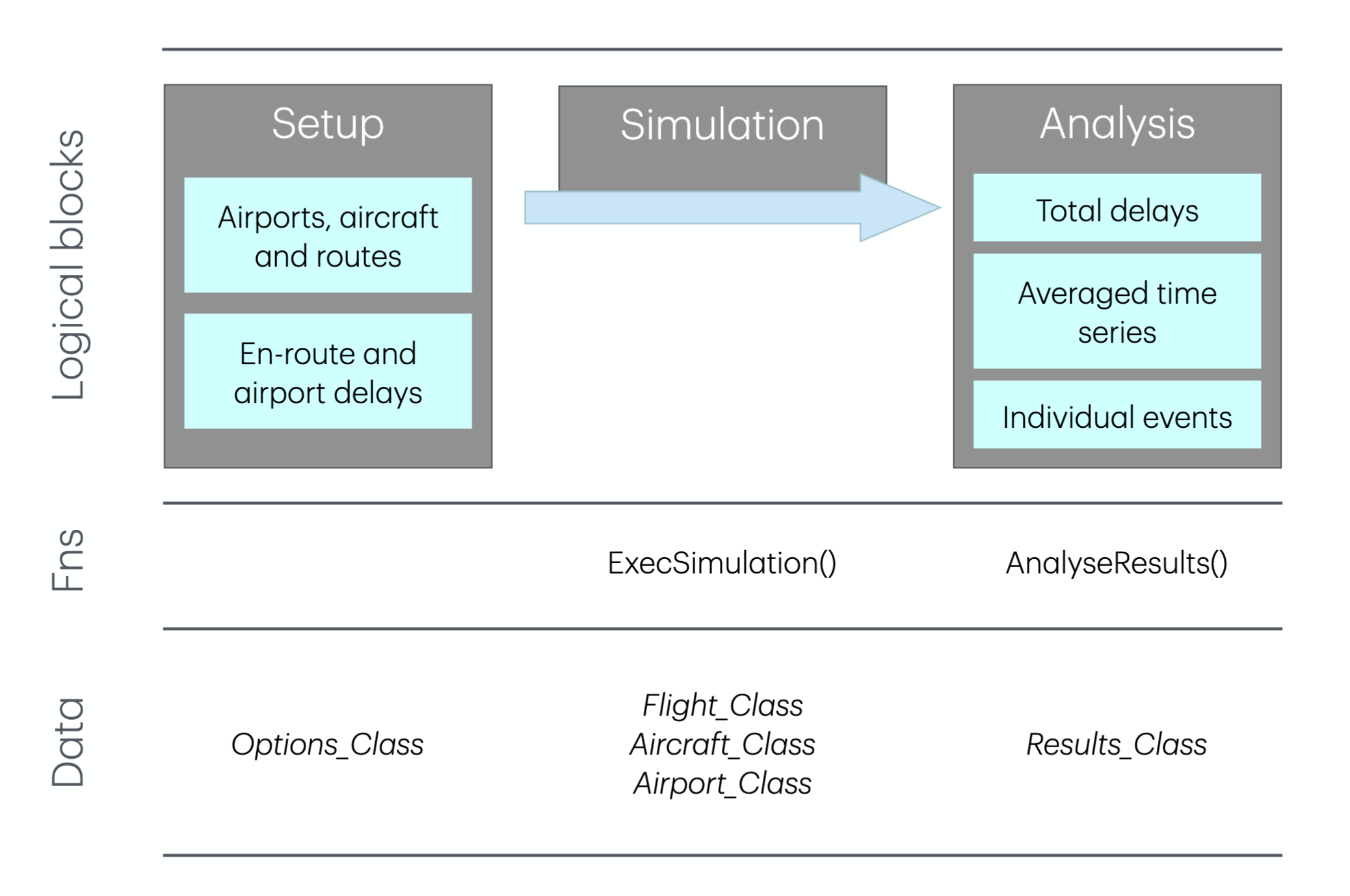 SynthATDelays: A Minimalist Python Package for the Generation of Synthetic Air Transport Delay DataCarlson Moses Büth, and Massimiliano ZaninAug 2025
SynthATDelays: A Minimalist Python Package for the Generation of Synthetic Air Transport Delay DataCarlson Moses Büth, and Massimiliano ZaninAug 2025@misc{buth2025-synthatdelays-preprint, title = {{{SynthATDelays}}: {{A Minimalist Python Package}} for the {{Generation}} of {{Synthetic Air Transport Delay Data}}}, shorttitle = {{{SynthATDelays}}}, author = {B{\"u}th, Carlson Moses and Zanin, Massimiliano}, year = {2025}, month = aug, number = {2025081091}, eprint = {2025081091}, publisher = {Preprints}, doi = {10.20944/preprints202508.1091.v1}, archiveprefix = {Preprints}, langid = {english}, } - Infomeasure: A Comprehensive Python Package for Information Theory Measures and EstimatorsCarlson Moses Büth, Kishor Acharya, and Massimiliano ZaninScientific Reports, Aug 2025
Information theory, i.e. the mathematical analysis of information and of its processing, has become a tenet of modern science; yet, its use in real-world studies is usually hindered by its computational complexity, the lack of coherent software frameworks, and, as a consequence, low reproducibility. We here introduce infomeasure, an open-source Python package designed to provide robust tools for calculating a wide variety of information-theoretic measures, including entropies, mutual information, transfer entropy and divergences. It is designed for both discrete and continuous variables; implements state-of-the-art estimation techniques; and allows the calculation of local measure values, \p\-values and \t\-scores. By unifying these approaches under one consistent framework, infomeasure aims to mitigate common pitfalls, ensure reproducibility, and simplify the practical implementation of information-theoretic analyses. In this contribution, we explore the motivation and features of infomeasure; its validation, using known analytical solutions; and exemplify its utility in a case study involving the analysis of human brain time series.
@article{buth2025-infomeasure, title = {Infomeasure: {{A Comprehensive Python Package}} for {{Information Theory Measures}} and {{Estimators}}}, shorttitle = {Infomeasure}, author = {B{\"u}th, Carlson Moses and Acharya, Kishor and Zanin, Massimiliano}, year = {2025}, month = aug, journal = {Scientific Reports}, volume = {15}, number = {1}, pages = {29323}, publisher = {Nature Publishing Group}, issn = {2045-2322}, doi = {10.1038/s41598-025-14053-5}, url = {https://www.nature.com/articles/s41598-025-14053-5}, urldate = {2025-08-11}, } - Preprint
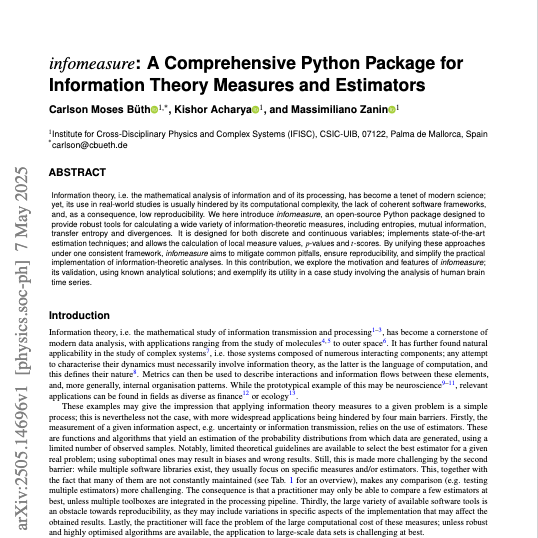 Infomeasure: A Comprehensive Python Package for Information Theory Measures and EstimatorsCarlson Moses Büth, Kishor Acharya, and Massimiliano ZaninMay 2025
Infomeasure: A Comprehensive Python Package for Information Theory Measures and EstimatorsCarlson Moses Büth, Kishor Acharya, and Massimiliano ZaninMay 2025Information theory, i.e. the mathematical analysis of information and of its processing, has become a tenet of modern science; yet, its use in real-world studies is usually hindered by its computational complexity, the lack of coherent software frameworks, and, as a consequence, low reproducibility. We here introduce infomeasure, an open-source Python package designed to provide robust tools for calculating a wide variety of information-theoretic measures, including entropies, mutual information, transfer entropy and divergences. It is designed for both discrete and continuous variables; implements state-of-the-art estimation techniques; and allows the calculation of local measure values, \p\-values and \t\-scores. By unifying these approaches under one consistent framework, infomeasure aims to mitigate common pitfalls, ensure reproducibility, and simplify the practical implementation of information-theoretic analyses. In this contribution, we explore the motivation and features of infomeasure; its validation, using known analytical solutions; and exemplify its utility in a case study involving the analysis of human brain time series.
title = {Infomeasure: {{A Comprehensive Python Package}} for {{Information Theory Measures}} and {{Estimators}}}, shorttitle = {Infomeasure}, author = {B{\"u}th, Carlson Moses and Acharya, Kishor and Zanin, Massimiliano}, year = {2025}, month = may, number = {arXiv:2505.14696}, eprint = {2505.14696}, primaryclass = {physics}, publisher = {arXiv}, doi = {10.48550/arXiv.2505.14696}, archiveprefix = {arXiv}, }
2024
- superblockify: A Python Package for Automated Generation, Visualization, and Analysis of Potential Superblocks in CitiesCarlson Moses Büth, Anastassia Vybornova, and Michael SzellJournal of Open Source Software, Aug 2024
@article{buth2024-superblockify, title = {superblockify: {{A Python Package}} for {{Automated Generation}}, {{Visualization}}, and {{Analysis}} of {{Potential Superblocks}} in {{Cities}}}, shorttitle = {Superblockify}, author = {B{\"u}th, Carlson Moses and Vybornova, Anastassia and Szell, Michael}, year = {2024}, month = aug, journal = {Journal of Open Source Software}, volume = {9}, number = {100}, pages = {6798}, issn = {2475-9066}, doi = {10.21105/joss.06798}, url = {https://joss.theoj.org/papers/10.21105/joss.06798}, urldate = {2024-08-14}, langid = {english}, } - Preprint
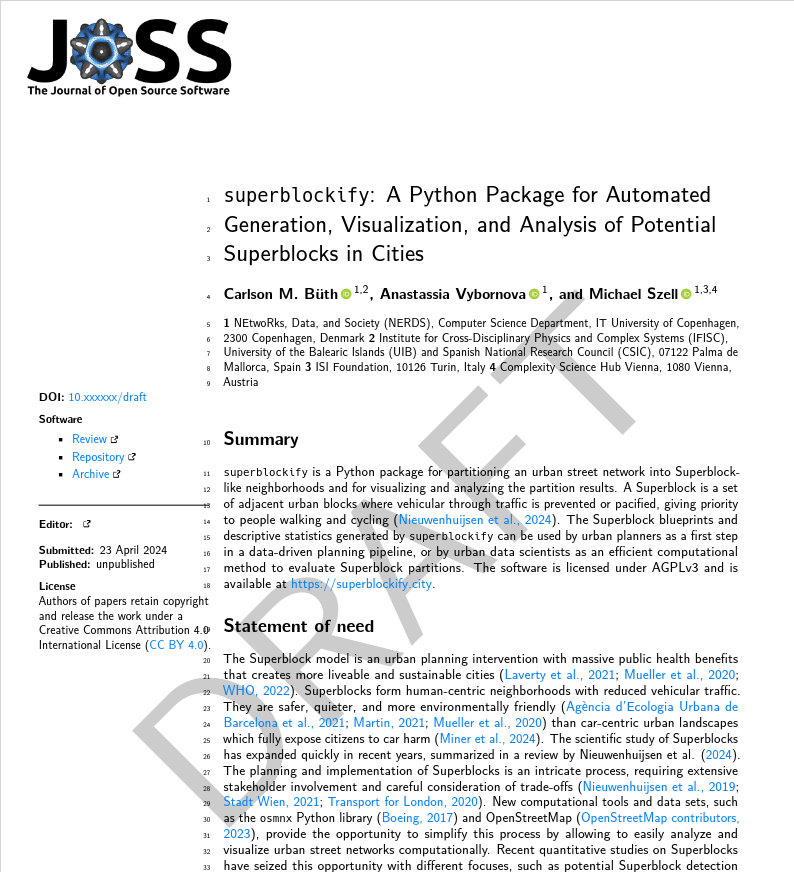 superblockify: A Python Package for Automated Generation, Visualization, and Analysis of Potential Superblocks in CitiesCarlson Moses Büth, Anastassia Vybornova, and Michael SzellApr 2024
superblockify: A Python Package for Automated Generation, Visualization, and Analysis of Potential Superblocks in CitiesCarlson Moses Büth, Anastassia Vybornova, and Michael SzellApr 2024superblockify is a Python package for partitioning an urban street network into Superblock-like neighborhoods and for visualizing and analyzing the partition results. A Superblock is a set of adjacent urban blocks where vehicular through traffic is prevented or pacified, giving priority to people walking and cycling. The Superblock blueprints and descriptive statistics generated by superblockify can be used by urban planners as a first step in a data-driven planning pipeline, or by urban data scientists as an efficient computational method to evaluate Superblock partitions. The software is licensed under AGPLv3 and is available at https://superblockify.city.
title = {superblockify: {{A Python Package}} for {{Automated Generation}}, {{Visualization}}, and {{Analysis}} of {{Potential Superblocks}} in {{Cities}}}, shorttitle = {Superblockify}, author = {B{\"u}th, Carlson Moses and Vybornova, Anastassia and Szell, Michael}, year = {2024}, month = apr, number = {arXiv:2404.15062}, eprint = {2404.15062}, primaryclass = {physics}, publisher = {arXiv}, doi = {10.48550/arXiv.2404.15062}, }
2023
- MSc Thesis
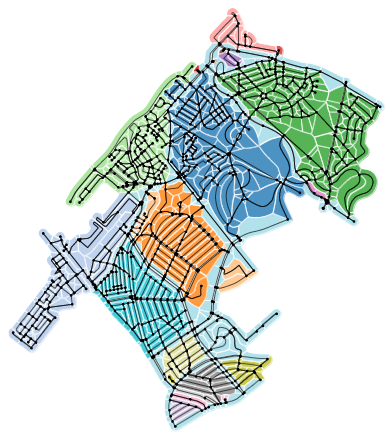 From Gridlocks to Greenways: Analyzing the Network Effects of Computationally Generated Low Traffic NeighborhoodsCarlson Moses BüthAG Wittkowski @ University of Münster and NERDS @ IT University of Copenhagen, Jul 2023
From Gridlocks to Greenways: Analyzing the Network Effects of Computationally Generated Low Traffic NeighborhoodsCarlson Moses BüthAG Wittkowski @ University of Münster and NERDS @ IT University of Copenhagen, Jul 2023This thesis investigates the impact of the spatial order of cities on the performance of presented, data-driven partitioning approaches. The study addresses two research questions: 1. How does the travel time change if all neighborhoods were Low Traffic Neighborhoods (LTNs)? 2. What LTN configuration can we suggest for different types of cities? We present a framework to analyze the impact of LTNs on travel time that utilizes Open Street Map (OSM) street data, and GHSL population data to calculate network measures, such as directness, global efficiency, average circuity, street orientation order. Central components of this work are the LTN generation, evaluation, and visualization. The evaluation of 100 global cities and 80 cities in Germany reveals that both a residential-based approach and a betweenness-based approach yield positive results, with minimal travel time increases. This research contributes to the understanding of the impact of LTNs on travel time and provides a framework for the simplified generation and evaluation of LTNs.
@phdthesis{buth2023master, author = {Büth, Carlson Moses}, title = {From Gridlocks to Greenways: Analyzing the Network Effects of Computationally Generated Low Traffic Neighborhoods}, school = {AG Wittkowski @ University of Münster and NERDS @ IT University of Copenhagen}, year = {2023}, month = jul, doi = {10.13140/RG.2.2.26204.36481}, } - Effectiveness of Bicycle Helmets and Injury Prevention: A Systematic Review of Meta-AnalysesCarlson Moses Büth, Natalia Barbour, and Mohamed Abdel-AtyScientific Reports, May 2023
To mitigate the risk of injuries, many countries recommend bicycle helmets. The current paper seeks to examine the effectiveness of bicycle helmets by performing a systematic review focusing on meta-analyses. First, the current paper explores the findings of studies that employ meta-analyses using bicycle crash data. Second, the results are discussed considering the findings from research analyzing bicycle helmet effectiveness in a laboratory using simulation, and then are complemented with key methodological papers that address cycling and the overall factors contributing to the injury severity. The examined literature confirms that wearing a helmet while cycling is beneficial, regardless of age, crash severity, or crash type. The relative benefit is found to be higher in high-risk situations and when cycling on shared roads and particularly preventing severe head injuries. The results from the studies performed in laboratories also suggest that the shape and size of the head itself play a role in the protective effects of helmets. However, concerns regarding the equitability of the test conditions were found as all reviewed studies used a fifty-percentile male head and body forms. Lastly, the paper discusses the literature findings in a broader societal context.
@article{buth2023, title = {Effectiveness of Bicycle Helmets and Injury Prevention: A Systematic Review of Meta-Analyses}, shorttitle = {Effectiveness of Bicycle Helmets and Injury Prevention}, author = {Büth, Carlson Moses and Barbour, Natalia and {Abdel-Aty}, Mohamed}, year = {2023}, month = may, journal = {Scientific Reports}, volume = {13}, number = {1}, pages = {8540}, publisher = {{Nature Publishing Group}}, issn = {2045-2322}, doi = {10.1038/s41598-023-35728-x}, url = {https://www.nature.com/articles/s41598-023-35728-x}, urldate = {2023-05-26}, copyright = {2023 The Author(s)}, langid = {english}, }
2021
- BSc Thesis
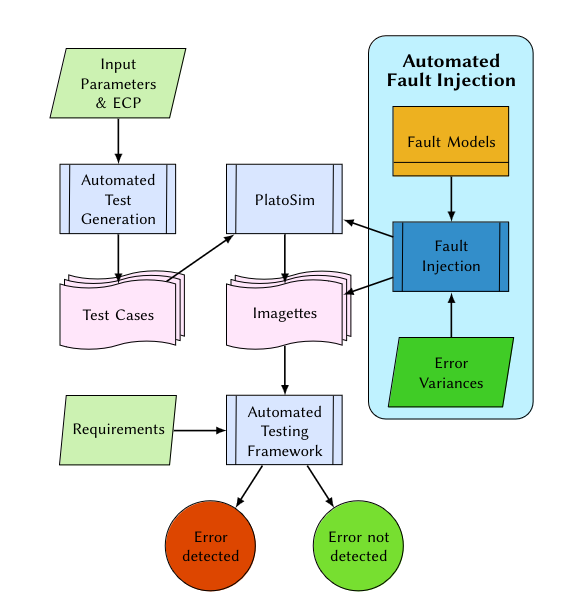 Fault Injection for Robustness Testing of Satellite On-Board Image ProcessingCarlson Moses BüthEmbedded Systems Group @ University of Münster, Jul 2021
Fault Injection for Robustness Testing of Satellite On-Board Image ProcessingCarlson Moses BüthEmbedded Systems Group @ University of Münster, Jul 2021@phdthesis{buth2021, author = {Büth, Carlson Moses}, title = {Fault Injection for Robustness Testing of Satellite On-Board Image Processing}, school = {Embedded Systems Group @ University of Münster}, year = {2021}, month = jul, }
2020
- BSc Thesis
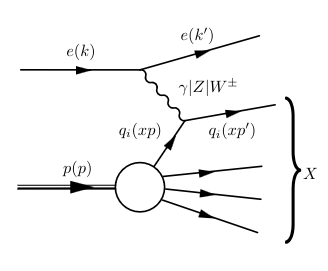 Deep Inelastic e±p Scattering with Boson Exchange and InterferenceCarlson Moses BüthInstitute of Theoretical Physics @ University of Münster, Aug 2020
Deep Inelastic e±p Scattering with Boson Exchange and InterferenceCarlson Moses BüthInstitute of Theoretical Physics @ University of Münster, Aug 2020@phdthesis{buth2020, author = {Büth, Carlson Moses}, title = {Deep Inelastic e±p Scattering with Boson Exchange and Interference}, year = {2020}, school = {Institute of Theoretical Physics @ University of Münster}, month = aug, }
